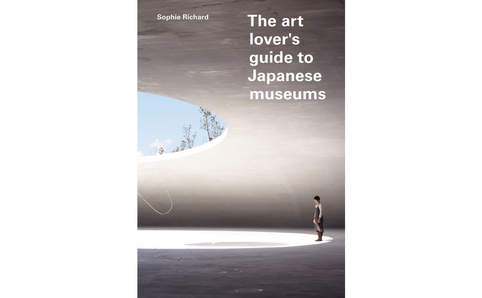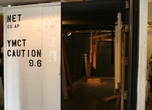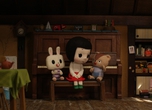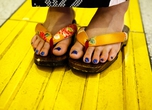The Art Lover's Guide to Japanese Museums
Author Sophie Richard lets us in on the charms of Japan's museum kingdom, explored in her new book

Nakamura Keith Haring Collection, Kobuchizawa, Yamanashi Prefecture
Posted: Fri Jun 27 2014

Where does an idea begin? For Sophie Richard (left), the idea to embark on a journey that would result in her publishing The Art Lover’s Guide to Japanese Museums came to her in a flash – or more likely, a gentle cedar wood-scented breeze – in the garden of Kyu Asakura House in Daikanyama. A small miracle among the concrete, as she describes it. ‘I found myself in front of a beautiful traditional house half hidden by tall trees, in the heart of one of Tokyo’s most fashionable areas,’ the France-born, London-based art historian writes in the introduction to her first book, launched in Tokyo in May 2014. ‘Realising that it was open to the public, I walked in and was transported into another era in absolute tranquillity.’
As Sophie and I sit down on a tiny wooden bench outside Ebisu's Japanese Ice Ouca, dipping into cups of green-tea ice cream served inexplicably yet satisfyingly with salty kombu (kelp) strips, I ask her about this moment; why it moved her to write what is the first English-language museums guide to be published in 30 years. ‘My journey to this point had actually started long before I chanced upon Kyu Asakura. But it is here where the book was born in my mind. It is very beautiful, with a very quiet garden, traditional architecture, tatami mats, the smell of Japanese cedar. It’s the kind of place you can really experience with all five senses. As I stood there, everything kind of came together and I thought, “Oh, I need to write this book.” So I’m very attached to this museum now.’
Tell us more about the journey
I’ve always been attracted to the culture and aesthetics of Japan, ever since I was young. The town I come from in the south of France actually has a traditional Noh stage, which I believe is the only one outside of Japan. So the culture has always been part of my inner landscape. When I started coming here on holiday, my fascination grew. Being an art historian, I of course began to explore the galleries and museums, and I was amazed at the variety. I realised how little is known outside of Japan about some of the smaller, private museums, and how little information there is in English about these places. I knew I wanted to turn my exploration into a professional project, but it was only when I visited Kyu Asakura that I decided what that project would be.
How long did it take the project to come into fruition?
Four years! It was a very personal journey; I did it all on my own, without any financial backing (although a Japanese sponsor jumped in at the end to help the book become a reality). I would visit Japan twice a year for three weeks at a time, and during those three weeks I would visit one or two museums every day, interviewing the directors. Then I’d return to London to write. All in all, I visited 100 museums, 55 of which are featured in the book – although an additional 25 are mentioned as at the end of each entry I also suggest other things to do in the area.
So the book is more than just a listing of museums
Oh yes, each museum has its own story, and I really wanted that individual character to come through. My aim is to show the variety and quality of the museums, and to show how they can be a gateway to the culture. For some people this gateway is film or perhaps the mountains; for me, it’s the museums. The other thing I love about Japanese museums is the attention to detail and the fantastic architecture, both traditional and contemporary. There is definitely more to see than what I’ve been able to fit into one book, but I think this is a good starting point for first-time travellers – whether they are exploring Tokyo or further afield.
Aside from Kyu Asakura, which one is your favourite?
That’s like asking which child is my favourite! [Laughs] The thing about Japanese museums is that they rotate their exhibitions all the time, so it really depends on what’s showing. But, if I have to choose, I like Nezu Museum in Tokyo very much. Apart from the amazing traditional Japanese art collection, it is set on the site of the Nezu family estate and surrounded by a wonderful garden. Also, one whole section is dedicated to the tea ceremony, so you can experience this tradition for yourself. In terms of architecture, I love the chic, sleek Suntory Museum.
Outside of Tokyo, Noashima Island is a very special place, known for its contemporary art and the large, permanent, site-specific art installations dotted around the island. All the museums are different and touch on different concepts – there is a lot about sustainability and restoring the landscape. Life is much slower here than in Tokyo, so it’s an all-round unique experience. I also really enjoy Towada Art Center in Aomori. It’s made up of an assortment of separate rooms on a lawn, surrounded by open-air artworks. It’s great fun going from one room to the next, not knowing what you’ll find inside each one.
And isn’t that exactly the joy of any journey – not knowing what’s next...
Exactly. I know there is still more to be done with this project; I’m waiting to see where it leads. I have already learnt so much about Japan and about the arts, and after interviewing 100 people, this became a very human experience too. Also, I’ve become a bit of an expert at train travel in Japan!

WIN THE BOOK
As advertised in the third issue of Time Out Tokyo magazine, we’re giving away three copies of The Art Lover’s Guide to Japanese Museums. To enter the competition, send your name, address and contact number to info@timeout.jp by August 31, 2014. The winners will be notified by email. Competition rules here.
BUY THE BOOK
The Art Lover’s Guide to Japanese Museums by Sophie Richard (The Japan Society, distributed by Bookend Publishing) is available for £18.99 (¥3,257) at Tokyo bookstores and museums, and from Amazon.
Tweets
- About Us |
- Work for Time Out |
- Send us info |
- Advertising |
- Mobile edition |
- Terms & Conditions |
- Privacy policy |
- Contact Us
Copyright © 2014 Time Out Tokyo














Add your comment